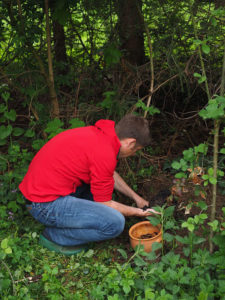
 Plant lifting is an essential task to carry out in your garden during the autumn months, especially towards the end of September to the beginning of October.
Plant lifting is an essential task to carry out in your garden during the autumn months, especially towards the end of September to the beginning of October.
Just like people, some plants can be sensitive souls when it comes to the cold weather, but for some plants such as fuchsias, geraniums and dahlias frost is a killer. As the temperatures drop, it’s time to start thinking about lifting some of your prize plants.
Plant lifting is the process of replanting flowers and shrubs, helping plants which are sensitive to colder temperatures to survive until the spring.
Why do I need to lift some plants?
Although some plants thrive in cooler conditions, for some plants frost can cause damage to both leaves and root systems. Lifting storing plants garden can help to protect them from winter weather.
If you’re new to the idea of plant lifting, we’ve put together a list of tips to help you help your plants survive this winter!
- Keep an eye out on the weather forecast: For some plants, when frost strikes, it can be too late! Look for early signs of frost and indications. Although it’s likely that only very sensitive or tropical plants are likely to be damaged by a light frost, it pays to take early action.
- Some plants can be trimmed and covered with mulch instead of removing and replanting. Only do this if these plants and shrubs are in a well sheltered and well drained area of your garden. Covering them with a mulch will protect them over the winter. Alternatively cover the plant with a bucket or plant pot to fend off the worst frost.
- When removing plants or shrubs from borders, care should be taken to not damage the roots. Use a fork to gently loosen the soil near the roots and take extra care not to damage the main root systems.
- If you are moving plants indoor, make sure they are re-planted in pots and housed in a frost-free, well ventilated space such as a house garage or shed. You don’t have to water them every day but ensure they are moist enough to survive.
- If you have recently planted bulbs which have not yet sprouted, remove them before the colder weather sets in. Bulbs won’t survive in the soil during the winter months and should be removed and placed in a frost-free area, such as a shed or house connecting garage.
- Remember to regularly rotate the soil. This ensures flowers and shrubs which can stand the winter months will last longer.
- Plant lifting helps with overcrowding in your garden and this autumn months are the best time to do this.
- As we live in the UK, you can guarantee some winter days will be wet rather than cold! Wet weather can also rot bulbs and root vegetables. If you think this may be happening, remove the plant immediately, taking care not to damage the plant, and move to a frost-free place.
Despite the cold weather, autumn is one of the best seasons for gardening. Take the time to maintain your garden and care for the array of plants and shrubs you already have. Remember you can still mow the lawn in the autumn but raise your lawn mower setting to winter height.
If you have any questions in regards to gardening in the autumn months, you can contact us via our website here: http://gardeningservicesyorkshire.co.uk/contact-us/

 Cerebral
Cerebral